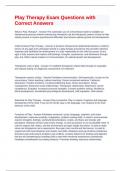Play Therapy Exam Questions with
Correct Answers
What is Play Therapy? - Answer-The systematic use of a theoretical model to establish an
interpersonal process wherein trained play therapists use the therapeutic powers of play to help
clients prevent or resolve psychosocial difficulties and achieve optimal growth and development.
Child-Centered Play Therapy - Answer-A dynamic interpersonal relationship between a child (or
person of any age) and a therapist trained in a play therapy procedures who provides selected
materials and facilitates the development of a safe relationship for the child (or person of any
age) to fully express and explore self (feelings, thoughts, experiences, and behaviors) through
play, the child's natural medium of communication, for optimal growth and development.
Therapeutic uses of play - Answer-To establish therapeutic relationship through an enjoyable
and natural setting, for diagnostic assessment, for treatment
Therapeutic powers of play - Answer-Facilitates communication: Self-expression, Access to the
unconscious, Direct teaching, Indirect teaching. Fosters emotional wellness: Catharsis,
Abreaction, Positive emotions, Counterconditioning fears, Stress inoculation, Stress
management. Enhances social relationships: Therapeutic relationship, Attachment, Social
competence, Empathy. Increases personal strengths: Creative problem solving, Resiliency,
Moral development, Accelerated psychological development, Self-regulation, Self-esteem.
Rationale for Play Therapy - Answer-Play is powerful. Play is natural. Cognitive and language
development of the child. Toys are the words, play is the language. Can respond to the total
behavior of the child.
Functions of Play - Answer-Facilitates emotional, social, language, cognitive, and motor
development. Improves creativity, imagination, problem-solving skills. Is used to communicate-
express thoughts, feelings, wishes/desires/fantasies, needs, and fears and reveals self-
perception. Releases tension and excess energy. Is used to practice or try out adult/life roles. Is
used to explore self, others, and the environment and gain insight into these. Is used to make
sense out of/organize one's experiences; thus gain more control and feel secure. Is used to
experiment with new behaviors and master new skills. Releases pent-up emotions (catharsis).
Resolves past and present problems and conflicts. Creates distance for feelings and attitudes
that are too threatening by enabling child to deal with emotional experiences symbolically.
Facilitates verbalization by creating distance. Promotes bonding; improves relationships.
, Directive Play Therapy - Answer-Structured. Therapist led. Prescriptive. Problem-focused.
Driven by specific goals. Want child to talk.
Nondirective Play Therapy - Answer-Unstructured. Child led. Nonprescriptive. child-focused.
Driven by general goals. Child doesn't have to talk.
Settings and Types of Play Therapy - Answer-Activity therapy. Family play therapy. Filial
therapy. Group play therapy. Kinder therapy. Play therapy with adolescents. Play therapy with
adults. Play therapy with the elderly. Play therapy with the elderly. Play therapy in hospitals
(child life therapists). play therapy in schools.
What does A4PT stand for? - Answer-Association for Play Therapy
What does RPT stand for? - Answer-Registered Play Therapist
What children learn in child-centered play therapy - Answer-Acceptance of one's feelings and
responsible control of them. Self-acceptance and self-respect. Self-direction and responsible
freedom of expression. Self-responsibility (ability to make choices and be responsible for them)
and self-control. Creativity and resourcefulness in confronting problems.
Objectives for the child - Answer-Develop a more positive self-concept. Assume greater self-
responsibility. Become more self-accepting, self-directing, and self-reliant. Engage in self-
determined decision making. Experience a feeling of control. Become sensitive to the process of
coping. Develop an internal source of evaluation. Become more trusting of self.
Axline's 8 Basic Principals - Answer-1. The therapist is genuinely interested in the child and
develops a warm, caring relationship. Establish rapport. 2. The therapist experiences
unqualified acceptance of the child and does not wish that the child were different in some way.
Accept child completely. 3. The therapist creates a feeling of safety and permissiveness in the
relationship, so the child feels free to explore and express self completely. Establish feeling of
permissiveness. 4. The therapist is always sensitive to the child's feelings and gently reflects
those feelings in such a manner that the child develops self-understanding. Recognize and
reflect feelings. 5. The therapist believes deeply in the child's capacity to act responsibly,
unwaveringly respects the child's ability to solve personal problems, and allows the child to do
so. Maintain respect for child and ability to resolve problems. 6. The therapist trusts the child's
inner direction, allows the child to lead in all areas of the relationship and resists any urge to
direct the child's play or conversation. Child leads the way and takes responsibility. 7. The
therapist appreciates the gradual nature of the therapeutic process and does not attempt to
hurry the process. Therapy can't be hurried. 8. The therapist establishes only those therapeutic




